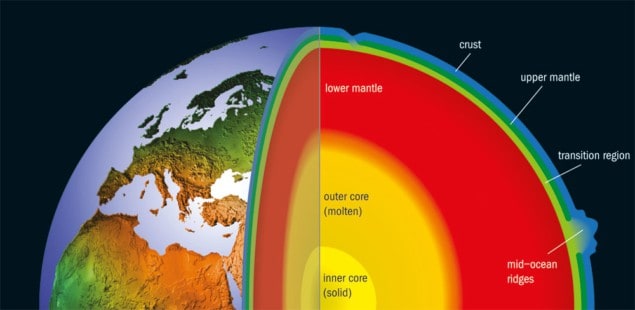
Researchers in Japan have new evidence that the Earth’s lower mantle contains more silicon than its upper mantle. The results suggest that the composition of the Earth’s silicates match the type of meteorites thought to exist in the solar nebula from which the Earth was created.
The Earth’s mantle can be divided into three sections: the upper mantle, which stretches from the thin crust down to about 400 km in depth; a transition zone of about 250 km; and finally the lower mantle, which stretches from the transition zone to about 2900 km in depth. Most geoscientists agree that the upper mantle is composed mostly of peridotite, a dense igneous rock containing a high proportion of the mineral olivine (Mg,Fe)2SiO4. At the transition zone, a change in the way seismic waves propagate has generally been explained by a phase transition in the structure of the olivine, suggesting that the lower mantle, too, is peridotite in composition. If this is true, however, the Earth would contain far less silicon than chondritic meteorites – the type of meteorites thought to exist at the time of the Earth’s formation.
More or less silicon?
In the past, this “missing silicon problem” has provoked much debate. Some geoscientists believe that the missing silicon must be made up in the Earth’s core, while others believe the lower mantle must contain an additional source of silicon. There has even been a suggestion that the meteorites from which the Earth formed contained less silicon than is generally assumed.
Now, geophysicist Motohiko Murakami of Tohoku University in Sendai and colleagues claim to have solved the missing silicon problem. They believe that the lower mantle in fact contains more silicon than the upper mantle – which is consistent with the Earth having been formed from chondritic meteorites. “The main result of our work is that the mantle has [a] chemically stratified structure with [a] silicon-enriched lower mantle in comparison with the upper mantle,” says Murakami.
Murakami and colleagues performed laboratory-based seismic-velocity measurements on two possible lower-mantel minerals – silicate perovskite, or (Mg Fe)SiO3, and ferropericlase, or (Mg,Fe)O – under very high pressures and temperatures. Comparing these measurements with actual seismic-velocity data using a model, the researchers found that more than 93% of the lower mantle should be made of perovskite, the silicon-rich mineral.
James Connolly, a geoscientist at the Swiss Federal Institute of Technology in Zurich, says that in recent years there has been a trend in seismic models towards a silicon-enriched lower mantle, although he adds that the enrichment proposed by Murakami and colleagues is the “most extreme” he has seen. He thinks the group’s conclusions are interesting because they support the notion that the mantle has two separate layers that circulate independently, and that the Earth was formed by accretion of chondritic meteorites. “The popularity of both of these hypotheses has been waning in recent years,” he says.
Some uncertainty
However, geophysicist Baosheng Li of Stony Brook University in New York thinks there may be a problem with the Japanese researchers’ modelling. For example, he says that there is a “large uncertainty” in their temperature measurements, which may compromise their conclusions. Still, he thinks the group’s techniques are, in general, “first class”. “I found this paper interesting, although in my personal view it still needs more data to confirm [that] the lower mantle holds the ‘missing silicon’,” he adds.
The research is described in Nature.



